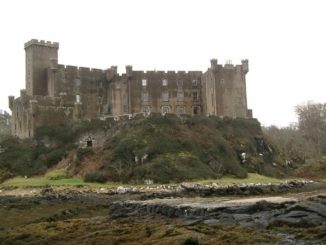PREFACE
I’d like to start this article by explaining I scan the comments as each part is published and decide whether or not to continue the series accordingly. I’m now too old to continue for vanity’s sake or because I think I can make any difference to the way in which political and social life develops or degrades so I pay most attention to comments with a topical or human relevance to my narrative. I cannot mention all who commented on Part 6 but do congratulate SharpieType 301 on correctly solving the admittedly easy anagram connecting my yacht’s name to my own, and Whistler80 who enjoys reading about other people’s adventurous lives and, I hope, enjoys some of his own. I also agree with Magic Flute’s advice to run before a storm but of course, that’s not always possible if there isn’t sufficient sea-room. There are many others too numerous to mention individually whom I would also like to thank for supporting the site and my contribution to it.
THE STORY CONTINUES
On 6 June 1996 I took delivery of my new yacht 18 months after deciding I needed to make a big change in my life.
I was quite sure both my wife and father would have approved my decisions and actions. They were both very positively minded and active people who would have been appalled if I had just sunk into the slough of despond. I had avoided that fate by plunging instead into a hectic period of intensive research and decision taking as recorded in earlier articles.
Now was the time to put into practice what I had been studying, considering, and deciding during those months.
The yacht had actually been delivered to Pacific Seacraft’s Agent several weeks earlier having been completed in the factory just before Easter. She was then trucked some 3,000 miles across the United States together with her dismounted mast and fixed rigging, put in a container and loaded onto a freighter that took her to Felixstowe, whence she was again trucked to Falmouth. Once there the Agent had mounted the mast and fixed rigging, supplied the Running Rigging, the anchor, chain, liferaft and fenders and commissioned the whole lot before inviting me to take her over.
Unbeknownst to me, the Agent had also made social contact with Malcolm Cockell, a retired ex-colleague of mine living near Truro, who was also a talented artist and commissioned from him a painting that was presented to me along with the real thing. The original water-colour still hangs on the wall of my living room but instead of reproducing that here I include below a photo taken from another I commissioned from him later in 1996 that also hangs on the wall next to the first.
I’ve lost touch with Malcolm during the last 24 years and think he probably still owns the copyright of the image but am confident he would agree to my non-commercial use of it to illustrate this article. He painted it from a photo taken during a review of my yacht by a journalist from one of the Yachting Magazines following the 1996 Boat Show when I agreed Alchemi could be exhibited there by Pacific Seacraft’s UK Agent.
In Malcolm’s painting he has placed the yacht just outside the Carrick Roads with St Anthony’s Head and Lighthouse as background and the Buoy at the harbour entrance marking the danger of an isolated rock with deep water all round it.
There were strong winds blowing about 35 knots on the day the journalist and I went for our review sail in the Solent so I rigged the boat with the Storm Jib, Staysail and a reefed Mainsail – not quite the “Rigged for Storm” of the title because that would have replaced the Main with the Trysail but OK for the relatively low waves encountered in the Solent.

A photograph of the yacht going strongly off the coast of North Eastern Queensland many years later was included in my first article in this series but I have been unable to find contemporary photos of her interior from 1996. Here are a couple taken 8 years later by which time the stainless steel of the clock and internal light cowls had started to become tarnished.
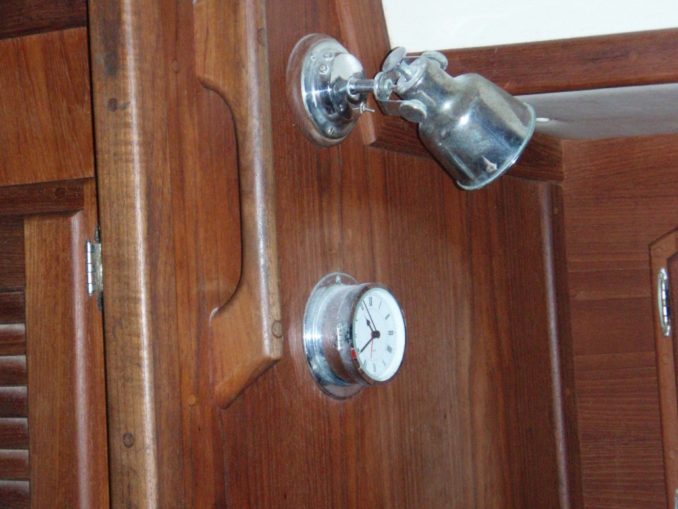
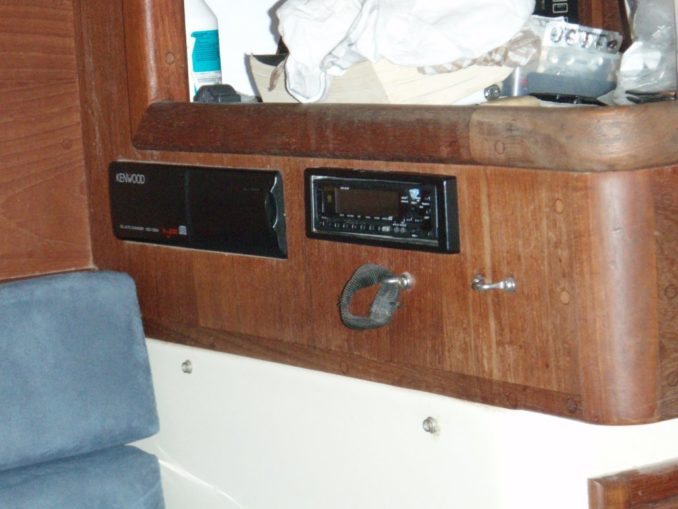
In passing I note these show the internal woodwork was solid Teak with an oiled finish rather than being varnished. That represented another choice between conflicting objectives. A varnished finish was more expensive originally, was more resistant to day-to-day dirt but would require much more work at greater expense when it became necessary to strip and renew it.
In contrast, the oiled finish preserved the natural appearance of the wood very well, and was relatively easy to clean and re-oil. But I have to add in fairness that moulds just loved the coconut oil finish and grew more quickly in hot, humid, tropical conditions during storage than they did on the varnished teak and holly sole of the cabins. In some places that could be avoided altogether by renting and running a dehumidifier during storage, but that wasn’t always possible.
When new, Alchemi had a beautiful but somewhat impractical blue cotton upholstery throughout. That lasted until I reached New Zealand at the end of 2003 and had it all renewed with still beautiful but harder wearing Alcantara in the main cabin and the exceptionally strong and waterproof Captain’s Navy canvas in the quarter-berth and fore-peak.
Because Pacific Seacraft’s agent was based in Falmouth that became my home port where Alchemi was kept for the next two and a half years when not away voyaging.
My initial outings were made in company with an experienced sailor employed as technical manager of the Yacht Sales and Charter Business run by Pacific Seacraft’s UK agent and based in Falmouth Marina at the mouth of the Penryn River close to its entrance to the Inner Harbour.
These outings were mostly undertaken in the Carrick Roads, a sheltered deep water area between the main body of the Cornish Coast and the long peninsula with St Anthony’s Head at its tip a mile or so east of Pendennis Head on the outskirts of Falmouth town.

Copy of Open Street Map licensed under CC BY-SA 2.0 in accordance with these terms.
Carrick Roads is undoubtedly the best deep water natural harbour in Cornwall and was recognised as such by the Tudors when Henry VIII had a castle and gun battery built on Pendennis Point to protect the entrance, and Elizabeth’s Naval Captains used it in the early stages of the running battle with the Spanish Armada. It was again used as a secure anchorage for shipping during WW II.
In the 19th Century Falmouth was an important fishing harbour famous for its pilchards and also for oysters dredged by Gaff-Rigged working boats with topsails. Nowadays that tradition is preserved by enthusiastic leisure sailors.
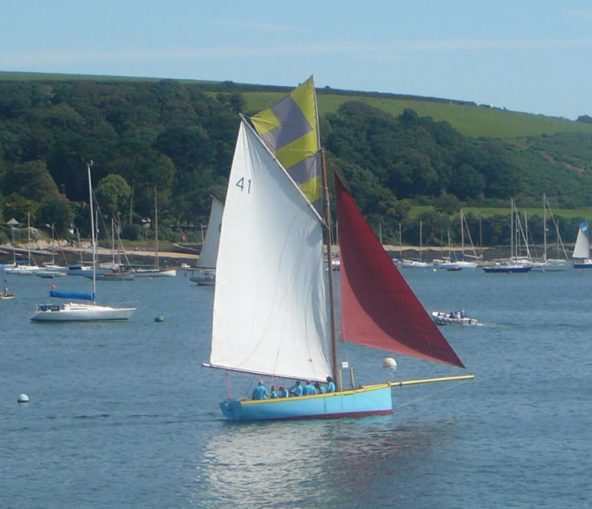
Falmouth was also an excellent base for my early expeditions into the offing because of two destinations within a few hours sail.
The nearest was the village and pub in the Helford River. This was only about 8 miles away so it was possible to sail there and back in about 4 hours making it an attractive destination for a day sail. When the wind was in its prevailing south westerly direction, and therefore blowing offshore, the waves were never high if a direct line was taken, with good protection at start and finish. There was usually a mooring buoy available at Helford to which one could tie the yacht and go ashore in the dinghy.

Copy of Open Street Map licensed under CC BY-SA 2.0 in accordance with these terms.
The destination itself, including the Shipwright Arms, was delightful and if you wanted an additional attraction you could dinghy upriver a short distance and explore Frenchman’s Creek, made famous by Daphne du Maurier’s novel of that name.

“File:Helford harbour geograph-3396814-by-Ben-Brooksbank.jpg” by Ben Brooksbank is licensed under CC BY-SA 2.0
One of my lessons at sailing school turned out to be very useful quite early on. It happened this way. The purpose of the outing was to try out the windlass and practice anchoring so we didn’t go far. In fact just south of the Helford River and anchored in the bay off the small village of Coverack.
The chain was satisfactorily withdrawn from the under-deck locker and lowered by the windlass to the seabed without a problem. It continued to pay out as I slowly reversed the yacht to ensure a total scope of some five times the depth, as recommended by experienced sailors to prevent wind and wave action from inadvertently lifting the anchor off the seabed.
Having secured the chain around a deck-cleat I then reversed slowly until it was stretched out almost horizontally instead of adopting its natural catenary profile when at rest. This is recommended to test that the anchor has definitely ‘dug-in’ to the seabed and won’t just skitter across its surface if strong loads are exerted on the boat by wind, waves and currents.
Elated at this success I lost focus when retrieving the anchor and breaking out the sails to get underway. The outcome was that a jib sheet escaped control and fell into the water whilst the propellor was still turning. I should have been paying closer attention to everything that was happening and put the engine out of gear as soon as the sheet went overboard. But, I didn’t, and suddenly there was a loud bang and the engine stopped as we slowly drifted on our way.
Yes, the low probability event of a rope getting twisted and locked around the propellor blades had happened on one of the very first outings and I didn’t know what to do about it. The only thing I could think of was to sail back into the mouth of the Penryn river to try and pick up a mooring whilst working out what to do next.
That is what we did thanks to those hours of practice sailing to a fixed point and then stopping for long enough to grab the ring at the top of a mooring buoy, pass a rope through it and tie off the free end to a deck cleat – whew!
I knew we couldn’t get back into the marina without getting the engine going again because it had a tight entrance with strongish currents flowing past it. Obviously I had to somehow get the rope off the propellor and see if the engine would start again. Fortunately the standard design of the Crealock 34 included a foldable step ladder at the stern and in those days I was not too stout to get into a dry suit whilst still wearing warm clothes.
Thinking of Errol Flynn in Nautical Mode, I donned my drysuit and snorkelling mask and lowered myself into the water inch by inch whilst clutching the family carving knife between my teeth. (Errol Flynn was a Derring-Do actor in adventure films of the 1940s and 1950s and the carving knife had the thinnest, sharpest blade in the drawer).

Cutting the rope away was not easy because I had to keep coming up for a breath of air followed by pulling myself underwater again and sawing away with the carving knife. Bit-by-bit I managed to cut away enough rope for the remainder to be drawn back on board with none left around the propellor.
The engine did start again and after the propellor had shaken itself a couple of times we were able to let go the mooring line and make our way back to the marina. Neither the engine, nor the propellor or its shaft seemed to be any the worse for this experience and I thought that twas a tribute to the strength of both and the benefit of a very short length of shaft outside the hull and beyond the cutless bearing.
I never again left the engine in gear if a rope fell overboard but did have two further incidents of this type with flotsam over the next 18 years. I’ll recount those if and when I get that far in my story.
The second attractive destination from Falmouth is Fowey, (pronounced “Foy” or something quite like that) just north of St Austell. This town is much larger than Helford and grew up around a church founded in the 600’s AD near the mouth of a river from which it took its name. Later it became an important port for fishermen, smugglers and the export of China Clay. Nowadays the town is still a Fishing Port but a high proportion of the local economy depends on tourism (at least it did in 1996 – I hope its not been too badly hit by the Government’s Lockdowns in 2020 and 2021).
Fowey is about 24 sea-miles from Falmouth so in my size of yacht it took some 5-6 hours each way and required an overnight stay in the harbour.

Copy of Open Street Map licensed under CC BY-SA 2.0 in accordance with these terms.
The river Fowey drains an extensive area with high hills so fresh water flows down it quite quickly and when combined with an ebb tide in its estuary this makes for pretty fast currents around the Harbour Master’s buoys and pontoons laid for use by local boats and visiting yachts.
I was glad of my practice during the marina-manoeuvering course at sailing school when coming alongside one such pontoon.
The problem is to get the side of the yacht close enough to the pontoon for a crew member carrying a mooring rope to jump from one to the other without allowing the yacht to be pushed aside by the fast-flowing water and either crash into the pontoon or move rapidly away from it.
I was fascinated to see one skipper achieve that by reversing into position instead of going bow first – that has the advantage the sideways force from the water has much less leverage between the rudder and the point on the boat first met by the fast-moving water so the bow moves about much more slowly and predictably – needs practice but doesn’t everything?
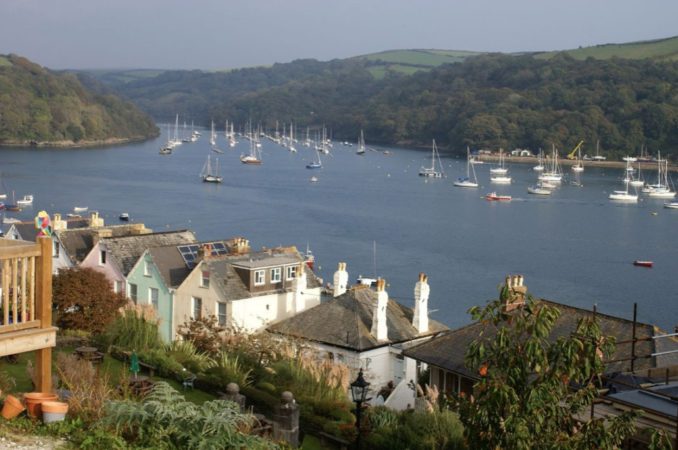
Once secured, in the 1990’s it was possible to either dinghy ashore or call a water taxi on the VHF – maybe it still is. The town itself is typically Cornish and at least in those days had a number of fine restaurants.
To Be Continued…
© Ancient Mariner 2021
The Goodnight Vienna Audio file


